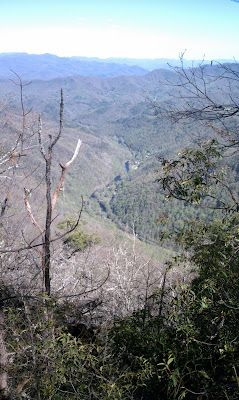While I didn't get burned, I did get scalded, a scolding from Mother Nature. Looking back I wish the name "Firescald" alone would have reminded me of that childhood aphorism. But then again, when you're hiking the AT, there aren't many decisions that you have to make. Sure, food is a big one; so is where you'll find water and make camp. Other than that, it's just a rather mindless exercise of following the blazes. Occasionally there won't be a blaze where you need one and you may not know at first which way to go. Other times you may find yourself perplexed at a double blaze, an indication that the trail does something that you should pay attention to: the start of a switchback, an intersection with another trail, or similar situation where if you're not observant you could easily find yourself walking off-trail.
So yes, there are decisions to be made, but Firescald Knob forced a new choice into my path: a choice between two viable options.
I took a moment to look at the sign, then looked up at the sky. There was plenty of gray, but that had been true all day. There was also plenty of wind, also present since morning. Given how normal the overcast, blustery weather had been I didn't give the sign much thought. Besides, why wouldn't I remain on the "true" AT path?
I went for the exposed ridge and was excited because a local told me that Firescald provided some of the best views from the trail thus far. As the trail wound up the ridge, the trees got smaller. Then the trees gave way to only rhododendron and mountain laurel, and before long even they became stunted in their growth due to the harsh, exposed ridge environment. Now being the tallest life form on the knob, I got my view and I didn't like what I saw.
The spine of Firescald stood tall, over 4500 feet high, towering over the valley to the west. As the westerly wind hit the mountainside it was hurled upward and its warm air collided with the cool, ridgeline atmosphere. The result: localized thunderhead clouds taking shape and billowing upward just to my left. Knowing that lightning can lead the edge of a storm by as many as ten miles, I now felt exposed on the "exposed ridge" trail. An impending sense of doom intensified as the first peal of thunder ripped across the sky. I suddenly felt taller than I ever had before.
So I did what anyone might do: snapped a picture to try and capture the moment, and then hightailed it north to lower elevations. The next half mile of scrambling across ridgeline rocks seemed like an eternity. I exhaled a welcome sigh of relief once I felt safe(er) amidst trees once again taller than me.
Later that evening I stopped at a shelter to enjoy a warm dinner: mac and cheese with tuna and freeze-dried peas, corn, and red bell pepper. Delicious. It was only 6:30 when I finished eating and the next shelter was six miles away with downhill terrain between. I could make it in two hours, so I pressed on. Soon after the sun dipped below the horizon, I crested a hill to find myself in a strange location. The ground was covered in healthy, green grass amidst a stand of pine that was mostly standing dead. I then passed multiple piles of bear scat adorning the trail, only to reach a headstone of a thirteen year-old girl who had lived and died in the late 1800's. The gravesite was decorated in fake flowers that looked strangely neon in the dusk sky. The whole stage left me with an eerie sensation, an acute visceral reaction that I wanted to leave the bears, the dead pine, and the fluorescing grave behind ... and quickly. It's a good thing it was dusk or I would have also noticed the perfectly preserved bear tracks in the nearby mud.
Two days later I found myself hiking up Big Bald. The morning air was crisp and the winds were high, sustained at 20 mph with gusts at 40 or more. As I crested Big Bald I hiked up and into the low-lying clouds. The suspended mist whisked by me, resembling the dust tossed up from a dry dirt road, recently disturbed by the tires of an old pickup. As I neared the top the wind grew in force, making it difficult for me to stay on the trail; each heavy gust left me as helpless as a piece of tumbleweed, tossed about like a rag doll. From the summit the trail dipped into a saddle and then back up the neighboring Little Bald. Venturing into the gap I marveled at the power of the wind. At eye level clouds were tearing in from the east of the bald as well as from the west, ripping past each other across the trail ahead of me. Just overhead there was a third wind pattern slinging clouds northward in the direction of my travel. I have never seen wind patterns with three different paths swirling in the same location, made visible by the misty clouds they took with them. It was truly a sight to behold.
It just goes show that mountain weather is an interesting, powerful and unpredictable force of nature.















